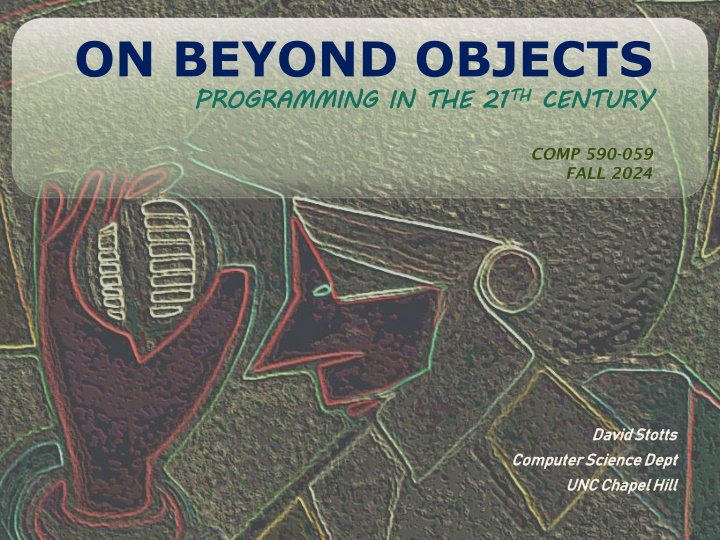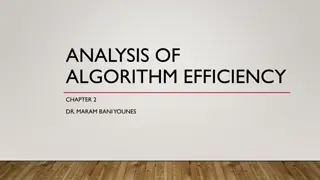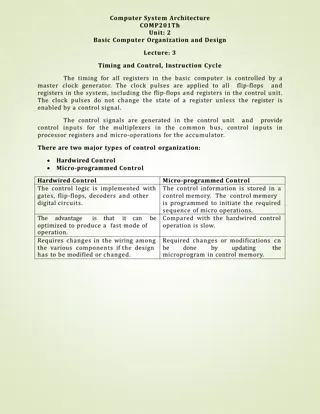
Exploring Go Language: A Modern Approach to Programming in the 21st Century
Discover the key aspects of the Go Language, its history, features, and unique characteristics that set it apart in modern programming. From its origins at Google to its focus on concurrency, performance, and simplicity, Go Language presents a new direction in programming languages with its statically typed, concurrent, and compiled nature. Dive into the world of Go to unlock its potential for efficient, scalable, and readable code development.
Download Presentation

Please find below an Image/Link to download the presentation.
The content on the website is provided AS IS for your information and personal use only. It may not be sold, licensed, or shared on other websites without obtaining consent from the author. If you encounter any issues during the download, it is possible that the publisher has removed the file from their server.
You are allowed to download the files provided on this website for personal or commercial use, subject to the condition that they are used lawfully. All files are the property of their respective owners.
The content on the website is provided AS IS for your information and personal use only. It may not be sold, licensed, or shared on other websites without obtaining consent from the author.
E N D
Presentation Transcript
ON BEYOND OBJECTS PROGRAMMING IN THE 21 PROGRAMMING IN THE 21TH THCENTURY CENTURY COMP 590-059 FALL 2024 David Stotts David Stotts Computer Science Computer Science Dept UNC Chapel Hill UNC Chapel Hill Dept
THE GO LANGUAGE ( GOLANG )
Go Lang History (reference) G o is designed at G oogle by R obert G riesem er, R ob Pike, K en Thom pson (U nix and B fam e) Started in 2007, first appears for use in N ov. 2009 V ersion 1.0 released M arch 2012 Intended for an era of m ulticore hardw are (concurrency), netw orked platform s, large codebases for new projects W anted to keep static typing, run-tim e efficiency (like C ) W anted readability and usability (like P ython) H igh-perform ance on netw orks and m ultiprocessors D evelopers did have a dislike of C++ in com m on D evelopers did have a dislike of C++ in com m on
Go Lang History D evelopers did have a dislike of C + + in com m on ( K en Thom pson, YouTube ) K en Thom pson interview The G o Team interview ed R ob Pike s 5 R ules of P rogram m ing R ob Pike: W hy G o is Successful? R ob Pike on P arallelism
Go Lang History New style of OO programming From the 2010 Bossie Award citation (14 years ago): G oogle s G o language tries to restore sim plicity to program m ing. It does aw ay w ith num erous constructs that have crept into all OO languages by re- im agining how to sim plify and im prove the conversation betw een a developer and the code. G o provides garbage collection, type safety, m em ory safety, and built-in support for concurrency and for U nicode characters. In addition, it com piles (fast!) to binaries for m ultiple platform s. G o is still in developm ent (new features are being added) and it has lim itations, notably poor support for W indow s. B ut it show s a new , exciting direction in program m ing languages.
Go Lang Go Features The language has Statically typed, m ultiple paradigm , com piled, general purpose Syntax is C-ish C oncurrent program m ing m ade for m ulti-core, uses go-routines and channels D eferred garbage collection, does not pause program execution N ot VM based, so faster than Java Type inference U nique error handling, using explicit return values N ot OO , no inheritance or reflection Supports unit-testing C om piled separately to binaries for each platform you w ish to run on ( m ore tranditionaly, not com pile-once-run-anyw here like Java ) B uilt-in package m anagem ent, using go m odules
Go Lang Basic Go Components basic data int, float, com plex, boolean, string, byte, rune (32-bit U nicode) data structures struct, array, slice, m ap scope global, or function-level export visibility outside files defining nam es types program m er defined pointers ( but no pointer arithm etic ) function can return m ultiple results m ethod a function attached to a struct (no objects) goroutine concurrency and synchronization, using channels functions as values closures interface goto goto, and label on statem ents
Go Lang First Go Program package main import "fmt func main() { fmt.Print("Hello ") x := sub_sq(15) fmt.Println(x) } func sub_sq ( x int) int { return x*x } Lets try this example in the Windows shell Put the code anywhere (for now). Lets make a file on my desktop
Go Lang Online Go execution https://play.go-lang.org/ Easy small Go program editing and execution Alternative to installing on your laptop/host Good for debugging small experiments
Go Lang Packages Packages are grouping units for code, helps to organize your project In Go every program is organized into one (or more) packages A package groups one (or more) source files The main package is special in Go, signifying that the package is executable The main package must contain a main() function. This function is the entry point of the program. When you run the program, Go looks for the main package and executes the main() function. So every executable Go program is a main package alone, or perhaps the main package with other packages
Go Lang Packages To use code in a package, you import the package Any code written in Go belongs to some package A package is like a name space Code in a package can use all functions and data defined in that package A package specifies what functions and data are exported Only exported names (function, variable) are visible to code outside the package Upper case first char is exported ( public and visible in all packages ) lower case first char is not exported ( private to the package ) By convention, package names are all lowercase, no space or _ Go Standard Library is a package, can be viewed here , compact for now
Go Lang Package Example Physically, a package is just a directory. Directory name and the package name should be the same a convention Go tools and programmers use this convention, so good idea to follow it Functions, types, variables, and constants defined in one source file are visible to all other source files within the same package example Executable program has one main package package main import "fmt" func main() { fmt.Print("Hello ") x := sub_sq(15) fmt.Println(x) } func sub_sq (x int) int { return x*x } That main package must have a main function Function main is the first to execute Package in general, however, need not have a main function
Go Lang Package Conventions We have already mentioned the convention that package names are all lowercase with no spaces or underscores Source file names by convention are all lowercase as well Source file names end in the .go extension A package can comprise multiple source files, and all are by convention located in one directory / folder Similarly, all source files in a folder are by convention in one package Package is all in one directory, each directory is a separate package -- These conventions are followed to limit confusion in code organization -- They can be broken, but doing so should require a good reason -- Following them makes your code readable by other Go programmers
Go Lang Global, Local Scopes Local scope is anything declared inside a function definition Global scope is anything outside all functions package main import "fmt" /* global variable declaration */ var g int func main() { /* local variable declaration */ var a, b int /* actual initialization */ a = 10 b = 20 g = a + b fmt.Printf("value of a: %d, b: %d and g: %d\n", a,b,g) }
Go Lang Global, Local Scopes package main import "fmt" /* global variable declaration */ var g int func main() { /* local variable declaration */ var a, b int /* actual initialization */ a = 10 b = 20 g = a + b fmt.Printf("value of a: %d, b: %d and g: %d\n", a,b,g) bump(3) fmt.Printf("value of a: %d, b: %d and g: %d\n", a,b,g) } New version Added another function to use the global var g func bump(n int) { g = g * n // note, no explicit return a := 5 // note := rather than = b := a + g } New version Local a and b created
Go Lang Global, Local Scopes package main import "fmt" /* global variable declaration */ var g int func main() { /* local variable declaration */ var a, b int /* actual initialization */ a = 10 b = 20 g = a + b fmt.Printf("value of a: %d, b: %d and g: %d\n", a,b,g) bump(3) fmt.Printf("value of a: %d, b: %d and g: %d\n", a,b,g) } New version Added another function to use the global var g := = func bump(n int) { g = g * n // note, no explicit return a := 5 // note := rather than = b := a + g } New version Local a and b created
Go Lang Block Scope package main import "fmt" func main() { x := 10 if true { y := 20 // Only exists within this if block fmt.Println("Inside if block:", x, y) } // fmt.Println(y) // this will cause a compile error: "undefined: y" for i := 0; i < 2; i++ { z := i * 10 // `z` is limited to this for loop block fmt.Println("Inside for loop:", z) } // fmt.Println(z) // this will cause a compile error: "undefined: z" }
Go Lang Type System Go has static typing of all data Types checked at compile-time Has type inference to make declaration simpler Has interfaces that introduce flexibility The simple yet powerful type system allows for -- type safety -- efficient memory usage -- clear code -- avoiding some complexities of other statically-typed PLs
Go Lang Type System Summary
Go Lang Type System Summary and so no multiple inheritance
Go Lang Type Inference package main this line declares, AND initializes What is the type of x ? Go is strongly typed import "fmt func main() { fmt.Print("Hello ") x := sub_sq( 15 ) fmt.Println(x) } func sub_sq ( n int) int { return n*n } Type is inferred from context, but it is one type chosen Here, x in main is given type int
Go Lang Type Inference Weaker than type inference in other languages, like SML/NJ In SML/NJ the type inference engine is used to create code that is as polymorphic as possible It creates code the will allow it to be run on any many different types as possible It only disallows a type is the ops in the code make no sense for that type $ sml -- fun max (x, y) = if x > y then x else y ; val max = fn : ''a * ''a -> ''a -- max (3, 5); val it = 5 : int As you write code, SML narrows down the applicable types until the function is completed, then reports the final type signature -- max (3.5, 2.5); val it = 3.5 : real -- max ("apple", "orange"); val it = "orange" : string
Go Lang Type Inference Weaker than type inference in other languages, like SML/NJ Here s an SML example that ends up allowing full, unqualified polymorphism $ sml -- fun ident x = x ; val ident = fn : 'a -> 'a -- ident 42; val it = 42 : int Type var a means any unqualified type can sub in -- ident "hello"; val it = "hello" : string a means any type that can be compared with = -- ident [1, 2, 3]; val it = [1, 2, 3] : int list
Go Lang Goroutines: Simple Example Concurrent threads/tasks/processes in Go package main import ( "fmt" "time" ) func hello(n int) { if n>0 { fmt.Printf("Hello world goroutine %p \n , n) go hello(n-1) // fires off a goroutine, concurrent } } func main() { go hello(5) //time.Sleep(1 * time.Second) time.Sleep(3100) fmt.Println("main function") }
Go Lang Arrays and Slices Summary comparison Arrays Fixed size defined at declaration, length is immutable Value type so when you assign array A to another array B, a complete copy of A is made Memory layout elements of an array are contiguous in memory Uses less common, when need efficiency and don t need dynamic length Declarationvar arX [10]string // 10 is the fixed length
Go Lang Arrays and Slices Summary comparison Slices Dynamic size wrapper on an array, grow and shrink as used Reference type so if we assign slice A to slice B, both point to same underlying array so changes to A can affect data in B Memory layout 3 components to a slice a pointer to array, slice length, and its capacity defining how far is can grow Uses used more often than arrays, when dynamic growth is needed, when efficiency is not critical Declaration slx := []int{20, 11, 37} // literal // or slx := make([]byte, 0, 8) // slice with length 0 and capacity 8
Go Lang Arrays and Slices Arrays have a fixed size that is part of their type, meaning their length cannot change after declaration. They are value types, so when assigned to a new variable or passed to a function, a copy of the entire array is made. Arrays are rarely used directly in Go because of their rigidity and inefficiency in many scenarios. Since they are allocated as a contiguous block of memory, they can be useful when dealing with low-level optimizations or when a fixed-size data structure is explicitly needed. Slices are more flexible, and more often used in Go. A slice is a descriptor that includes a pointer to an underlying array, a length, and a capacity. Slices provide dynamic resizing by using the built-in append function, which creates a new slice with increased capacity when needed. Unlike arrays, slices are reference types, meaning when passed to a function, modifications to the slice affect the underlying array. This makes slices more efficient for working with collections of data where the size is not known in advance. Also then a means of data sharing CGPT Summary
Go Lang Array an array is a num bered sequence of elem ents of a specific length H om ogenous the type of an array elem ent is statically declared The length is fixed, cannot be lengthened, index starts at 0 b := [5]int{1, 2, 3, 4, 5} fmt.Println("dcl:", b) package main var twoD [2][3]int for i := 0; i < 2; i++ { for j := 0; j < 3; j++ { twoD[i][j] = i + j } } fmt.Println("2d: ", twoD) } import "fmt" func main() { var a [5]int fmt.Println("emp:", a) a[4] = 100 fmt.Println("set:", a) fmt.Println("get:", a[4]) fmt.Println("len:", len(a))
Go Lang Array an array is a num bered sequence of elem ents of a specific length H om ogenous the type of an array elem ent is statically declared The length is fixed, cannot be lengthened, index starts at 0 b := [5]int{1, 2, 3, 4, 5} fmt.Println("dcl:", b) -- len is a built in function -- not a method of types slice, array package main -- it s polymorphic, works for these types: var twoD [2][3]int for i := 0; i < 2; i++ { for j := 0; j < 3; j++ { twoD[i][j] = i + j } } fmt.Println("2d: ", twoD) } import "fmt" func main() { var a [5]int fmt.Println("emp:", a) Channels: Returns the number of elements queued in the channel. Arrays: Returns the number of elements in the array. Slices: Returns the number of elements in the slice. Strings: Returns the number of bytes in the string. Maps: Returns the number of key-value pairs in the map. a[4] = 100 fmt.Println("set:", a) fmt.Println("get:", a[4]) fmt.Println("len:", len(a))
Go Lang Array fruit := [3]string{ peach", apple , grape } // array fruit := [10]string{ peach", apple , grape } // array fruit := [...]string{ peach", apple , grape } // array fruit := []string{ peach", apple , grape } // slice A n array in G o is a value A n array variable denotes the entire array Internally, it is not a pointer to the first array elem ent (like in C , or Java). Im plications of this are that w hen you assign or pass around an array value you w ill m ake a copy of its contents. To avoid the copy you could create and pass a pointer to the array but then that s a pointer to an array, not an array (slice is a pointer to an array, w ith extra data) One w ay to think about arrays is as a sort of struct but w ith indexed rather than nam ed fields: a fixed-size com posite value.
Go Lang Slice make vs. new new new returns a pointer to the zero value of the type passed to new m ake m ake returns a non-pointer (a value) for an initialized structure m ake m ake is only valid to use w ith slice, m ap, and channel return of m ake m ake w ill be assigned to a local or global var, w hich w ill have been created (in the rt stack, e.g.) w ith enough space to hold the com posite value new new can be used on any type, and a pointer is returned if w e create a slice w ith new new w e get no underlying array and no data structure to hold the length and capacity (sim ilar w ith m ap, channel) new
Go Lang Slice Rule for basic, simple Go (this class) U se slices you probably don t really need arrays U se slices you probably don t really need arrays If you only use slices, you all the functionality of arrays Plus you get dynam ic length This com es at the cost of perhaps som e execution speed You probably don t need the extra bit of execution efficiency in m any if not m ost G o codes W ith arrays, you have the Java situation fixed length and if you find its not long enough, it s a problem
Go Lang Slices vs. Arrays ( reference ) The data in a slice is stored contiguously in an array. A slice also deals with adding an element if the backing array is full, or shrinking the backing array if it s near empty. Internally, a slice holds a pointer to the backing array plus a length and a capacity. The length is the number of elements the slice contains, whereas the capacity is the number of elements in the backing array, counting from the first element in the slice. Another implementation of slice discussion s := make([]int, 3, 6) // declare 3-length, 6-capacity slice // ^ 2nd arg (capacity) is optional // zero filled by default
Go Lang Slices vs. Arrays ( reference ) Make creates an underlying array with 6 elements (capacity), then creates the slice data structure to point to the array Only the first len elements are initialized ( using 0 since the elements are int ) fmt.Println(s) // prints range 0..2, the len, get [ 0 0 0 ] s[1] = 1 // alters the second element value in the array No change to len or capacity
Go Lang Slices vs. Arrays ( reference ) Accessing an element outside the len range is forbidden, even though the underlying array seems to have space Use the append built-in function to extend a slice s[4] = 2 // generates panic, since the slice has no [4] element s = append(s, 2) // extends slice len, cap stays same <-- Changes the len property of the slice
Go Lang Slices vs. Arrays ( reference ) What happens if we need to add three more elements so that the backing array isn t large enough? The append can handle this, and here is what happens s = append(s, 3, 4, 5) fmt.Println(s) // output is [0 1 0 2 3 4 5] <-- might now be garbage cap is doubled
Go Lang Slices vs. Arrays ( reference ) The old array will be garbage collected (if it is not referenced by other slices) Slicing can be done on an array or another slice s1 := make([]int, 3, 6) // Three-length, six-capacity slice s2 := s1[1:3] // Slicing from indices 1 to (not including) 3 cant go beyond underlying array
Go Lang Slices vs. Arrays ( reference ) If we update s1[1] or s2[0] ( or any common elements), the change is made to the same array, hence, visible in both slices s1[1] = 1 // or s2[0] = 1 fmt.Println(s2[0]) // prints 1, both slices see common values
Go Lang Slices vs. Arrays ( reference ) What happens if we append an element to s2 ? Does this code change s1 as well? s1 s2 = append(s2, 2) s2 len of s1 does not change <-- len of s2 changes fmt.Println(s1) // output is [0 1 0] fmt.Println(s2) // output is [1 0 2]
Go Lang Slices vs. Arrays ( reference ) What if we keep appending elements to s2 until the backing array is full? Let s add three more elements so that the backing array will not have enough capacity: s2 = append(s2, 3) s2 = append(s2, 4) // At this stage, backing is already full s2 = append(s2, 5) s1 <-- double original s2 cap
Go Lang Array and Slice Example // example partially generated by chatGPT package main import "fmt" func main() { // --- Array Example --- var arr [5]int // Declare an array of length 5 // type is: [5]int array of int length 5 arr[0] = 10 // Assign values to the array arr[1] = 20 fmt.Println("Array:", arr) // Output: Array: [10 20 0 0 0] // Accessing array elements by index fmt.Println("First element of array:", arr[0]) // Output: 10 // Arrays have a fixed size, try to go out of bounds causes an error // arr[5] = 50 // This would result in a compile-time error fmt.Println("Array length is ", len(arr)) // Output: Array length is 5 arr[4] = 50 // last element is at subscript length-1 fmt.Println("Array:", arr) // Output: Array: [10 20 0 0 50] // --- Slice Example --- sl := make([]int, 3) // Declare a slice of length 3 using make sl[0] = 100 // Assign values to the slice sl[1] = 200 fmt.Println("Slice:", sl) // Output: Slice: [100 200 0]
Go Lang Array and Slice Example // Accessing slice elements by index fmt.Println("First element of slice:", sl[0]) // Output: 100 // Slices are dynamic, you can append more elements sl = append(sl, 400, 500) // Append new values to the slice fmt.Println("Slice after append:", sl) // Output: // Slice after append: [100 200 0 400 500] // Slices can also dynamically grow and shrink in size fmt.Println("Length of slice:", len(sl)) // Output: 5 fmt.Println("Capacity of slice:", cap(sl)) // Output: 6 // ( capacity may be greater than len // due to internal optimizations) // Slices share the underlying array with the original slice slCopy := sl[:3] // Create a new slice referencing the same underlying array fmt.Println("Slice copy:", slCopy) // Output: [100 200 0] slCopy[0] = 999 fmt.Println("Modified Slice Copy:", slCopy) // Output: [999 200 0] fmt.Println("Original Slice after modifying copy:", sl) // Output: [999 200 0 400 500]
Go Lang Array and Slice Example // lets dynamically grow the slice again with an append and see how much // the capacity goes up sl = append(sl, 700, 800, 1000) // Append new values to the slice fmt.Println("Length of slice:", len(sl)) // Output: 8 fmt.Println("Capacity of slice:", cap(sl)) // Output: 12 // ( capacity might be doubled // over the 6 it had before // lets dynamically grow it one more time sl = append(sl, 1, 2, 3, 4, 5) // Append 5 new values to the slice, this // exceeds the capacity since it is 13 values fmt.Println("Length of slice:", len(sl)) // Output: 13 fmt.Println("Capacity of slice:", cap(sl)) // Output: 24 // --- Differences between Arrays and Slices --- // 1. Arrays have a fixed length, slices are dynamic and can grow. // 2. Arrays cannot be resized, while slices can be resized with append. // 3. Slices are refs to underlying arrays, changes in one slice can affect others. }
Go Lang Closures When functions are first class entities A closure is a first class function which captures the lexical bindings of free variables in its defining environment. Practical definition means a dynamically-created function that can execute properly because the runtime system has set up a collection of any non- local variables it might need When a function is written its text may depend on variables in the calling environment (globals, vars local to the function calling it, etc. A closure makes a referencing environment that allows the function to run when called in any circumstances, even ones where the needed environment is not extant So a closure is a run-time creation a function and some encapsulated data whatever it takes to make that function execute as the definition suggests when it is called later after creation
Go Lang Closure Example package main import "fmt" func adder() func(int) int { sum := 0 // needed by the returned func // but not inside the func defn return func(x int) int { sum += x return sum } } func main() { pos, neg := adder(), adder() // pos and neg are int -> int functions for i := 0; i < 10; i++ { fmt.Println( pos(i), neg(-2*i)) } }
Go Lang Closure Example in Go package main import "fmt" Closures have some object characteristics func adder() func(int) int { sum := 0 return func(x int) int { sum += x return sum } } Encapsulation You can make many of them from one definition func main() { pos, neg := adder(), adder() for i := 0; i < 10; i++ { fmt.Println( pos(i), neg(-2*i)) } }
Go Lang Closure Example package main // makes closure using a global var import "fmt" var g_fac int = 0 func adder() func(int) int { sum := 0 return func(x int) int { sum, g_fac = sum+x*(g_fac), g_fac+1 return sum } } func main() { fmt.Println(g_fac) g_fac++ // btw in go the inc operator is a statement // not an expression fmt.Println(g_fac) pos, neg := adder(), adder() // both using one global? for i := 0; i < 10; i++ { fmt.Println( pos(i), neg(-2*i)) } }
END END






















